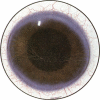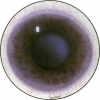Abstract
Amiodarone, a powerful antiarrhythmic agent recently made available in Britain, is known to cause corneal changes, but the clinical implications of this unwanted effect are still controversial. We have made serial observations on 105 patients treated with the drug for periods ranging from 3 months to over 7 years. Corneal abnormalities were detected by slit-lamp examination in 103 patients (98%). These always progressed over several months but subsequently showed a stable pattern which changed only with alteration of dose. The abnormalities regressed and disappeared within 7 months in the 16 patients whose treatment was discontinued for reasons unconnected with ocular changes. No macular changes or permanent sequelae occurred. Ocular symptoms were unusual: 6 patients had reactions in the skin of the eyelids, and 6 others had minor symptoms related to the corneal changes. We do not believe that ophthalmological surveillance is mandatory in asymptomatic patients on long-term amiodarone therapy.
Full text
PDF



Images in this article
Selected References
These references are in PubMed. This may not be the complete list of references from this article.
- Babel J., Stangos N. Lésions oculaires iatrogènes; l'action d'un nouveau médicament contre l'angor pectoris. Arch Ophtalmol Rev Gen Ophtalmol. 1970 Mar;30(3):197–208. [PubMed] [Google Scholar]
- Bron A. J. Vortex patterns of the corneal epithelium. Trans Ophthalmol Soc U K. 1973;93(0):455–472. [PubMed] [Google Scholar]
- D'Amico D. J., Kenyon K. R., Ruskin J. N. Amiodarone keratopathy: drug-induced lipid storage disease. Arch Ophthalmol. 1981 Feb;99(2):257–261. doi: 10.1001/archopht.1981.03930010259007. [DOI] [PubMed] [Google Scholar]
- François J. Cornea verticillata. Doc Ophthalmol. 1969;27:235–251. doi: 10.1007/BF00208693. [DOI] [PubMed] [Google Scholar]
- HOBBS H. E., CALNAN C. D. The ocular complications of chloroquine therapy. Lancet. 1958 Jun 7;1(7032):1207–1209. doi: 10.1016/s0140-6736(58)91911-1. [DOI] [PubMed] [Google Scholar]
- Mann I. "BLUE HALOES" IN ATEBRIN WORKERS. Br J Ophthalmol. 1947 Jan;31(1):40–46. doi: 10.1136/bjo.31.1.40. [DOI] [PMC free article] [PubMed] [Google Scholar]
- Marcus F. I., Fontaine G. H., Frank R., Grosgogeat Y. Clinical pharmacology and therapeutic applications of the antiarrhythmic agent amiodarone. Am Heart J. 1981 Apr;101(4):480–493. doi: 10.1016/0002-8703(81)90140-x. [DOI] [PubMed] [Google Scholar]
- Mathalone M. B. Eye and skin changes in psychiatric patients treated with chlorpromazine. Br J Ophthalmol. 1967 Feb;51(2):86–93. doi: 10.1136/bjo.51.2.86. [DOI] [PMC free article] [PubMed] [Google Scholar]
- Rosenbaum M. B., Chiale P. A., Halpern M. S., Nau G. J., Przybylski J., Levi R. J., Lázzari J. O., Elizari M. V. Clinical efficacy of amiodarone as an antiarrhythmic agent. Am J Cardiol. 1976 Dec;38(7):934–944. doi: 10.1016/0002-9149(76)90807-9. [DOI] [PubMed] [Google Scholar]
- Shearer R. V., Dubois E. L. Ocular changes induced by long-term hydroxychloroquine (plaquenil) therapy. Am J Ophthalmol. 1967 Aug;64(2):245–252. doi: 10.1016/0002-9394(67)92518-4. [DOI] [PubMed] [Google Scholar]
- Vérin P., Gendre P., Barchewitz G., Laurent-Bronchat G., Yacoubi M., Morax S. Thésaurismose cornèenne par amiodarone. Données récentes. Arch Ophtalmol Rev Gen Ophtalmol. 1971 Aug-Sep;31(8):581–596. [PubMed] [Google Scholar]
- Watillon M., Lavergne G., Weekers J. F. Lesions cornéennes au cours du traitement par le cordarone (chlorhydrate d'amiodarone) Bull Soc Belge Ophtalmol. 1968;150:715–726. [PubMed] [Google Scholar]
- Wright P. Untoward effects associated with practolol administration: oculomucocutaneous syndrome. Br Med J. 1975 Mar 15;1(5958):595–598. doi: 10.1136/bmj.1.5958.595. [DOI] [PMC free article] [PubMed] [Google Scholar]




